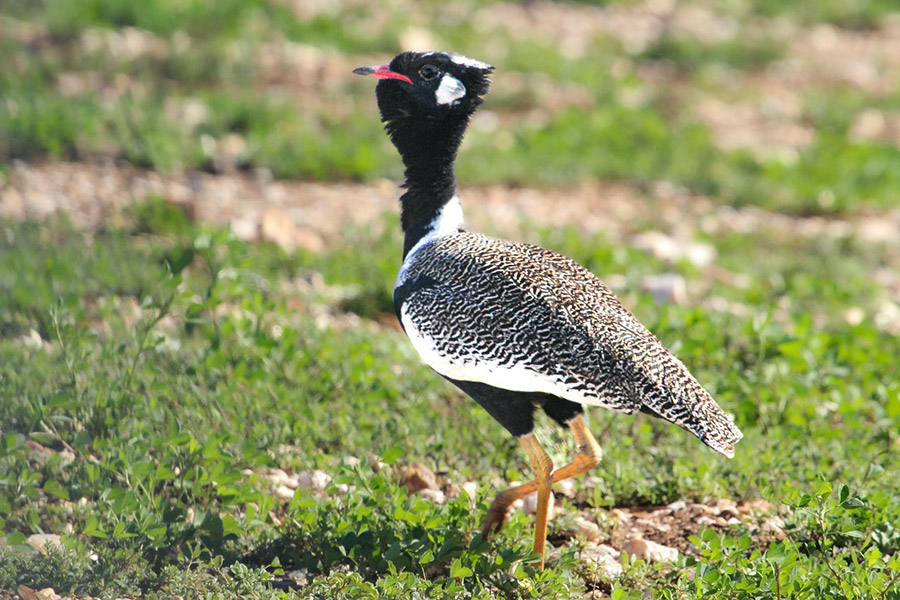There are about 130 reasons to come birding in the renosterveld of the Haarwegskloof Reserve. This renosterveld reserve, situated between Bredasdorp and Swellendam in the Overberg, offers the largest intact stretch of renosterveld left on Earth. And that makes it a favourite for many bird species that rely on this natural vegetation, part of the Cape Floral Kingdom, to breed and feed.

Above: Malachite Sunbird
To date, CEO of the Overberg Renosterveld Conservation Trust (ORCT) Odette Curtis-Scott, Conservation Manager Grant Forbes (both birders) and the rest of the team have tallied up a total of more than 130 bird species on the reserve. But interesting and unusual birds are often seen passing through the reserve, and so that list is constantly growing.
Odette says, “We’ve made it a fun challenge for our conservation team, and for the birders who visit this reserve to try and help us increase the number. Most recently we added Jacobin Cuckoo to the list – which was an exciting addition. And last year we were thrilled to see Western Osprey heading over during our Birding Big Day count.”
For birders, here are the top five incentives to come and bird in this area.

Your gold prize sighting: Black Harrier
The Endangered Black Harrier has become the flagship birding species for renosterveld conservation. Because it relies on these intact natural patches to lay its eggs and raise its young, the ORCT has launched a project to protect Black Harriers, by understanding them better. Fifteen renosterveld-breeding Black Harriers were tagged with GPS tracking devices, to monitor their movements.
Odette says, “When we see Black Harrier, we always consider it a privilege: There are only 1300 mature individuals left on the planet, and this enigmatic raptor is facing extinction. So for us, seeing them hunt over renosterveld is one of our favourite birding moments.”

Above: Endangered Black Harrier
The soaring scavengers passing over: Cape Vulture
The Haarwegskloof Renosterveld Reserve is perfectly situated between the Potberg colony of Cape Vultures, and some of their scavenging grounds in the Overberg. So watching these majestic birds soar overhead in the morning, while enjoying a morning coffee on the stoep of the guest accommodation is a sight to behold.
Grant, who has lived on Haarwegskloof, says, “We sometimes see groups of 10-20 vultures cruising over the reserve. We are so grateful to the farmers who leave carcasses out for them, so that they still have a reliable food source in this heavily transformed landscape.”

Above: Cape Vulture
Spot the covert Korhaans: Southern Black Korhaan and Karoo Korhaan
For the ORCT, while both species are threatened and therefore special, the Southern Black Korhaan in particular is a wonderful sighting, as they are far more dependent on the natural remnants than their cousins which seem to spend most of their time in the farmlands. These birds are very secretive, and you’ll usually see them as they sneak into a patch of natural bush, or squawking loudly as they fly away.
Odette says, “We know from SABAP (South African Bird Atlas Project) data that numbers of Southern Black Korhaan have decreased in recent years. We’re reaching out to partners to collaborate on understanding these declines so that we know what conservation actions are needed to protect them.”

Above: Southern Black Korhaan
The leading LBJs: Don’t miss this essential endemic
The Haarwegskloof Renosterveld Reserve is home to many Little Brown Jobs. The fun Cape Clapper Lark is frequently seen ‘clapping’ his wings above renosterveld, before diving down. Red-capped Lark and Large-billed Lark are also all easily spotted during a renosterveld stroll or a drive around the surrounding farmlands. But the standout LBJ is undoubted the Agulhas Long-billed Lark – one of the few bird species that is endemic to the Western Cape, only occurring around the most southerly tip of Africa. As a result, it’s listed as Near Threatened.
Grant says, “Until recently, very little was known about these larks. However, recent research by Sanjo Rose, which included the larks breeding on our Haarwegskloof Renosterveld Reserve, provided essential info on them, and highlighted how important renosterveld is to their survival. The research also shows that nest failure was particularly high, with only four broods successful from 29 nests.”


Top: Cape Clapper Lark. Bottom: Agulhas Long-billed Lark
Varying vagrants who visit the reserve
Over the years, the conservation team has identified a number of interesting migrants and vagrants stopping off to rest and recuperate in the renosterveld, before heading off. Pretty migrant visitors include European Bee-eater, Lesser Kestrel and Jacobin Cuckoo.

Help us find…
There are many more species to discover on our renosterveld reserve. And birders are welcome to visit, stay over in the Old Dairy Guest Accommodation, and enjoy some serious birding, while connecting with the peaceful and soul-restoring ambiance that this natural world offers.
Odette says, “Every year, we add more surprising or unexpected species to the list. So we ask that birders send us records of interesting sightings, especially with some photos and location pins. In this way, we can add to the conservation efforts, while also becoming an easily accessible birding destination for nature lovers.”
How about a club visit?
Bird clubs are also invited to come for a night or three, and search for some of the renosterveld specials during your stay. Make use of the amenities available for group visits – including the bedrooms in the Old Dairy Guesthouse, and additional bedrooms in the Research Centre (these are a little more rustic). Enjoy group meals in The Shed Learning Centre, and you can even organise guest speakers during your stay, making use of the space available in the Learning Centre for presentations.
Chat to Sharon to find out more: bookings@overbergrenosterveld.org.za


